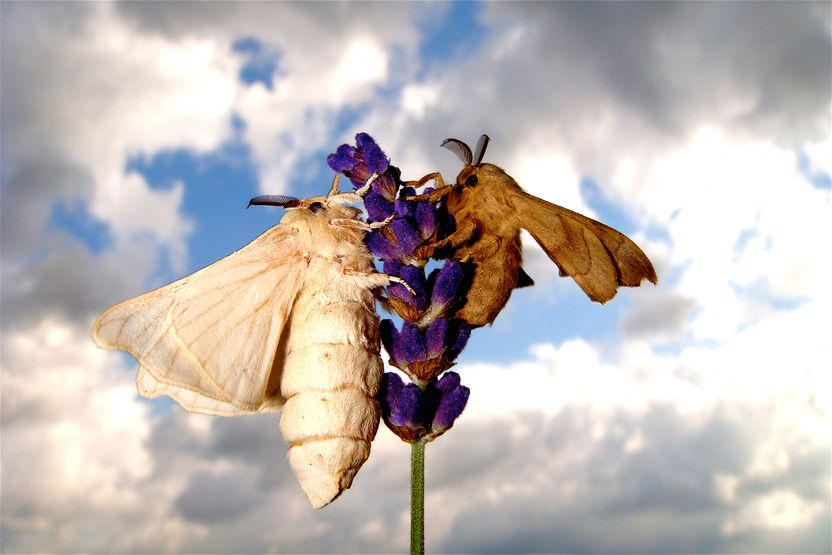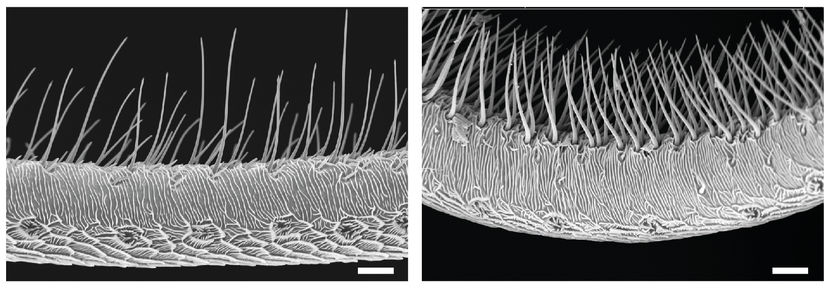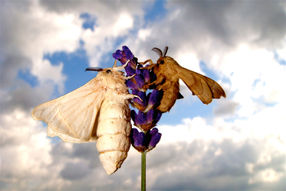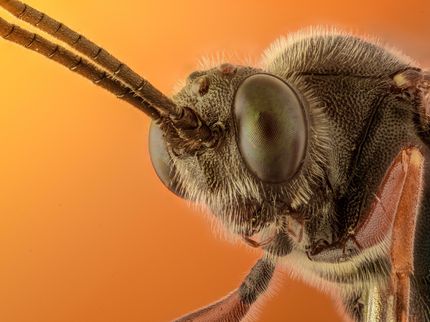Captive Breeding for Thousands of Years Has Impaired Olfactory Functions
Advertisement
Domesticated silkmoths Bombyx mori have a much more limited perception of environmental odors compared to their wild relatives. The extremely sensitive olfactory detection of pheromones in males eager to mate, however, remains unaltered.

Bombyx mori (left) and Bombyx mandarina (right) females. The domesticated moth has lost its camouflage coloration as well as its ability to fly.
Markus Knaden, MPI Chem. Ecol.

In the domesticated species the number of sensilla is considerably reduced (left) in comparison to its closely related wild ancestor (right).
Sonja Bisch-Knaden, MPI Chem. Ecol.


A new study on silkmoths revealed that the insects’ ability to perceive environmental odors has been reduced after about 5000 years of domestication by humans. Scientists from the Max Planck Institute for Chemical Ecology in Jena, Germany, and their colleagues from Japan compared olfactory functions in Bombyx mori and in their wild ancestors. Perception of the pheromone bombykol, however, remained highly sensitive in domesticated males.
Silk: A natural product for 5000 years
The silkmoth Bombyx mori, originally native to China, was domesticated about 5000 years ago. Its larvae, silkworms, enclose themselves in a cocoon when they enter the pupa phase. They spin their cocoon from one single silk thread, which is several hundred meters long. For silk production, the cocoon − together with the pupa inside − is boiled and the silk filament is then unraveled. Special breeding moths are kept for silk farming. After mating female moths lay several hundred eggs from which the new silkworms hatch.
In the 1950s Bombyx mori became a model organism in modern olfactory research. The sex pheromone bombykol, released by female silkmoths, was the first insect pheromone to be characterized chemically. Bombyx mori males’ are highly sensitive to even a few molecules of the female attractant, and the sensilla on their antennae are easily accessible for electrodes. This made them an ideal model system for electrophysiological measurements to analyze their olfactory functions. As early as 1956, olfactory receptor responses, so-called electroantennograms, were recorded on Bombyx mori.
Still responsive to pheromones, but not to environmental odors
Scientists from the Department of Evolutionary Neuroethology at the Max Planck Institute for Chemical Ecology and their collaborators from Japan have found that Bombyx mori is now considerably impaired in its olfactory functions due to 5000 years of captive breeding. The moth’s perception of environmental odors, which may lead it to its exclusive host plant, the mulberry tree, has been significantly reduced. This was demonstrated when their responses to odor stimulation were compared to those of the closely related wild species Bombyx mandarina. The scientists recorded electroantennograms of individuals of both species that were stimulated with different scents from leaves or flowers.
Morphological analysis revealed that the number of sensilla on the antennae of Bombyx mori females is considerably reduced compared to the abundant sensilla of Bombyx mandarina. In addition, the researchers measured different activity patterns in the brain of the domesticated and the wild silkmoths by using calcium imaging techniques. These patterns were highly variable among individuals of domesticated silkmoths but were largely constant in their wild ancestor group as well as in four other insect species.
Compared to wild moths, domesticated silkmoths seem to have less ability to smell environmental odors with their antennae and to locate host plants due to several millennia in captivity. As oviposition substrate is provided by humans, this ability has become redundant. In the wild, however, selecting an adequate oviposition site is crucial for the survival of the offspring, and thus helps preserve the species.
On the other side, perception of the female-produced attractant bombykol in Bombyx mori males is unabated, although it is not necessary anymore to find the females, as they are presented to the males by the breeders. Probably because bombykol not only attracts males but also triggers mating behavior in the males, it has remained indispensable for reproductive success.
Domestication effects are localized on the sex chromosome
Unlike in mammals, the female ovule determines the sex of the offspring in moths and butterflies. The distinction is made, analogous to the XY chromosomes, between W and Z chromosomes. Males have ZZ, females WZ chromosomes. Because both species, B. mori and B. mandarina, can still be crossbred, the scientists bred hybrids and used them for further olfactory experiments. “The modification of the Bombyx mori olfactory system, namely the reduced perception of environmental odors, is very likely caused by mutations on the female W chromosome. Differences in the signal processing in the moth’s brain, however, are not located on the sex chromosomes,” Sonja Bisch-Knaden, first author of the study, summarizes the results of the hybrid experiments.
Combining classical methods of electroantennogram recordings with advanced imaging techniques to analyze responses in the olfactory centre of the silk moth brains opens new perspectives in olfactory research: from molecule to behavior.
























































